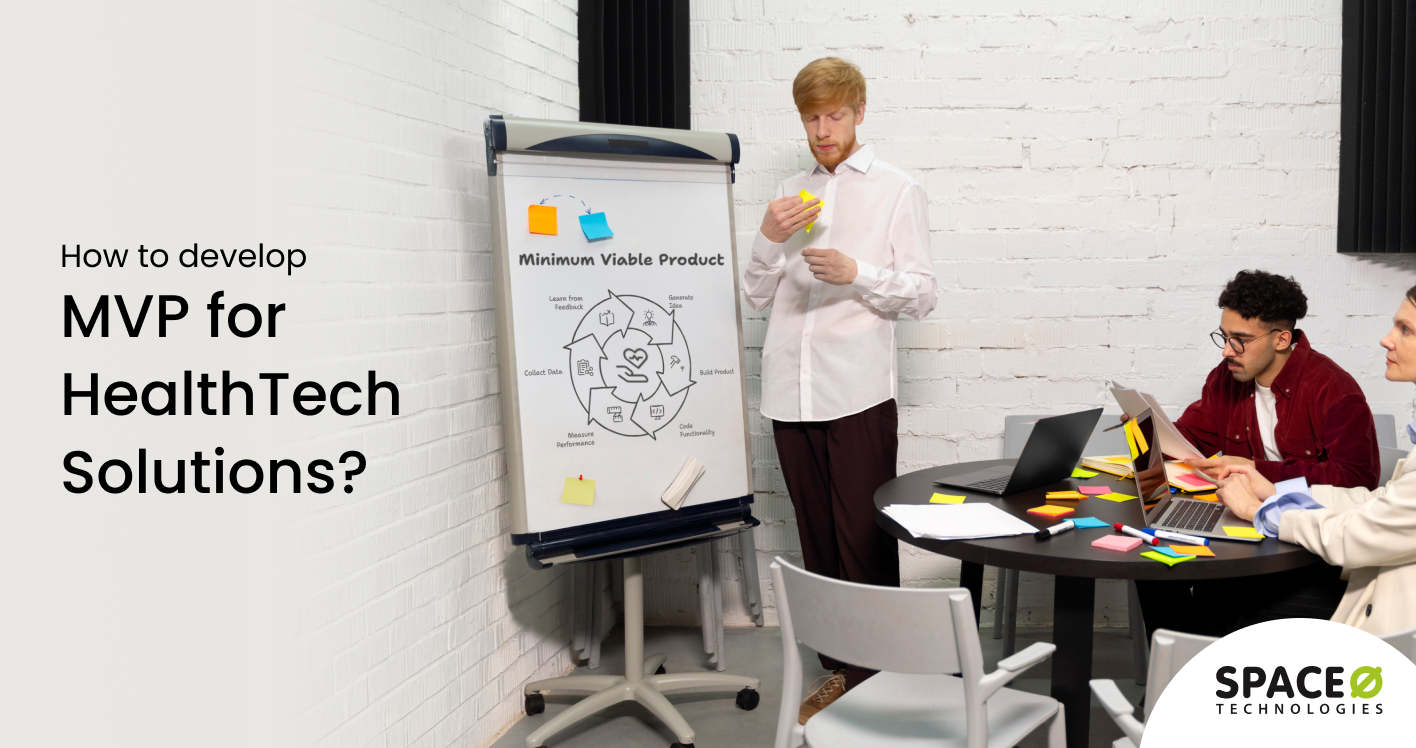Contents
Building healthcare software sounds exciting, right? But here’s the harsh reality: most healthcare apps and digital solutions fail before reaching the market.
Why does that happen? This includes —
- Endless software development cycles.
- Sky-high budgets with no returns.
- Compliance nightmares (HIPAA, GDPR, HL7).
- Healthcare providers are struggling with user adoption.
- And worst of all, building features nobody needs.
Does this sound familiar? It might feel too real if you’re a healthcare startup founder, project owner, product manager, CTO, or anyone trying to digitalize patient care with a new viable product.
Here’s the thing: building a healthcare product isn’t just about writing code or adding cool features. It’s about solving pain points, earning user trust, and launching strategically. And that’s precisely where a minimum viable product for healthcare plays a crucial role.
Building an MVP is the first and foremost step to proceed with for any software solution development. However, if you’re stuck on developing your healthcare MVP the right way, collaborating with an experienced MVP development company can make the process much easier.
From shaping core features to handling technical complexities, data encryption, and compliance standards, expert teams can help you turn your brilliant idea into something tangible, valuable, and ready for early adopters.
This write-up will help you understand how to plan, build, and validate a successful MVP for healthcare without wasting effort, budget, or time in the wrong direction. It covers everything you need to confidently take your MVP software from concept to reality, from identifying essential features and managing compliance, estimating costs, and learning from real-world successful MVP examples.
Let’s dive in with an introduction to MVP in healthcare.
What is Minimum Viable Product for Healthcare?
A minimum viable product (MVP) for healthcare is a compliant first version of a health tech solution built with essential features, like patient onboarding, secure data encryption, and appointment scheduling, to address core pain points. It’s released to early adopters to collect feedback and validate learning, guiding further development.
Partnering with a healthcare app development company can streamline each stage of the MVP development process. They can help ensure your solution adheres to industry standards and meets user expectations.
Why HealthTech Startups Must Start with an MVP?
Building a new healthcare product means navigating limited budgets, stringent compliance, and complex customer needs, where errors in the software development process can jeopardize patient trust and safety.
Rushing into full‑scale MVP software development without a strategic approach and real-world testing of product ideas often wastes effort on unproven ideas and features customers won’t use.
A minimum viable product for healthcare, created as a basic version through a clear MVP process, lets you enter the market quickly, gather feedback collected from early adopters, and refine core features before investing heavily in additional features.
Top 6 Benefits of Starting with a Healthcare MVP
Starting with a healthcare MVP empowers startups to take a strategic approach to product development. Here are the key benefits that developing a MVP for startups a smart choice.
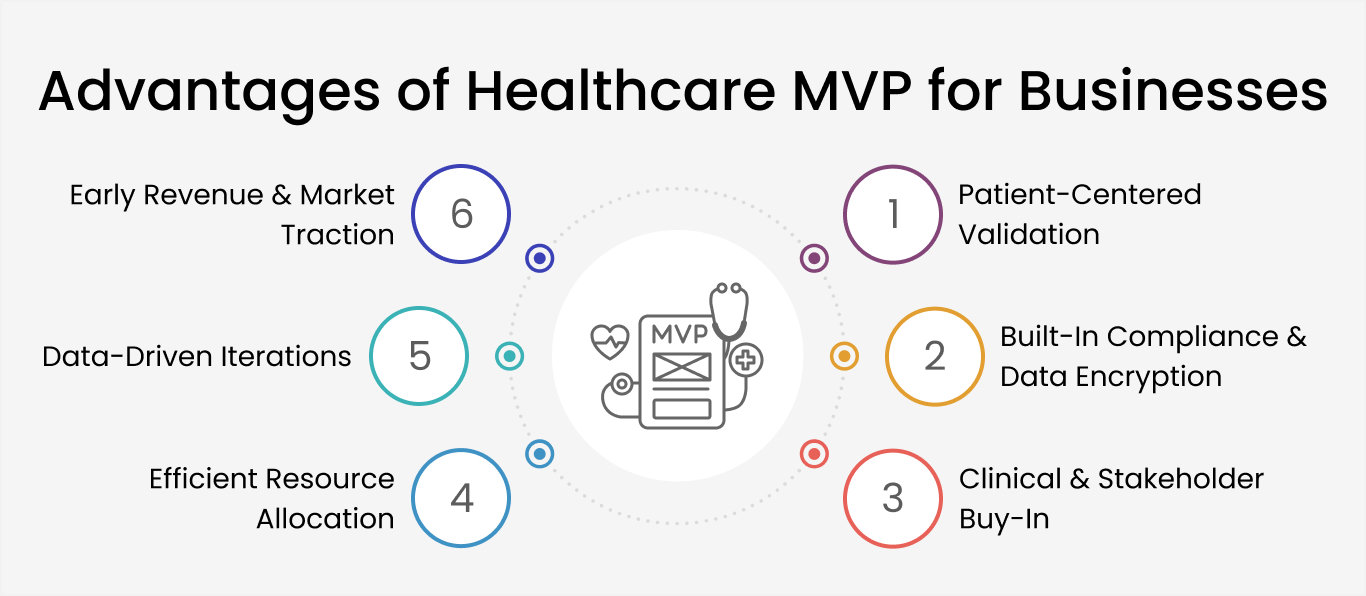
- Patient-Centered Validation: Conduct MVP testing with early adopters from your target audience to gather feedback on core features that address real patient pain points in healthcare apps.
- Built-In Compliance & Data Encryption: Embed HIPAA/GDPR standards and data encryption from day one. It ensures your healthcare product aligns with compliance standards and reduces regulatory risk.
- Clinical & Stakeholder Buy-In: Present your minimum viable product MVP to healthcare providers and payers, using test results to secure partnerships and validate your business model.
- Efficient Resource Allocation: Focus on essential features and core technology only, minimizing effort and avoiding heavy investment in unproven ideas.
- Data-Driven Iterations: Leverage user feedback and growth metrics to adapt quickly, refine product design, and plan new features through a step-by-step guide.
- Early Revenue & Market Traction: Launch pilot programs to potential users in your target market, generating initial revenue and demonstrating success to investors.
These are the core benefits of starting with a healthcare MVP. Now, that brings us to the next big question…How do you develop an MVP that works in the real world?
Let’s break down the MVP mobile app development process into simple, actionable steps to help you move from an idea to a market-ready healthcare product, with clarity, speed, and minimum risk.
Kickstart Your Patient‑Centered MVP Development?
Contact us today for a free consultation and discover our agile process for delivering high‑impact healthcare solutions on time and within budget.

Step-by-Step Process to Develop a Minimum Viable Product for Healthcare
Developing an MVP for healthcare isn’t just about coding quickly; it’s about creating a user-focused solution while ensuring compliance, security, and scalability from the start. Here’s a step-by-step roadmap to follow:
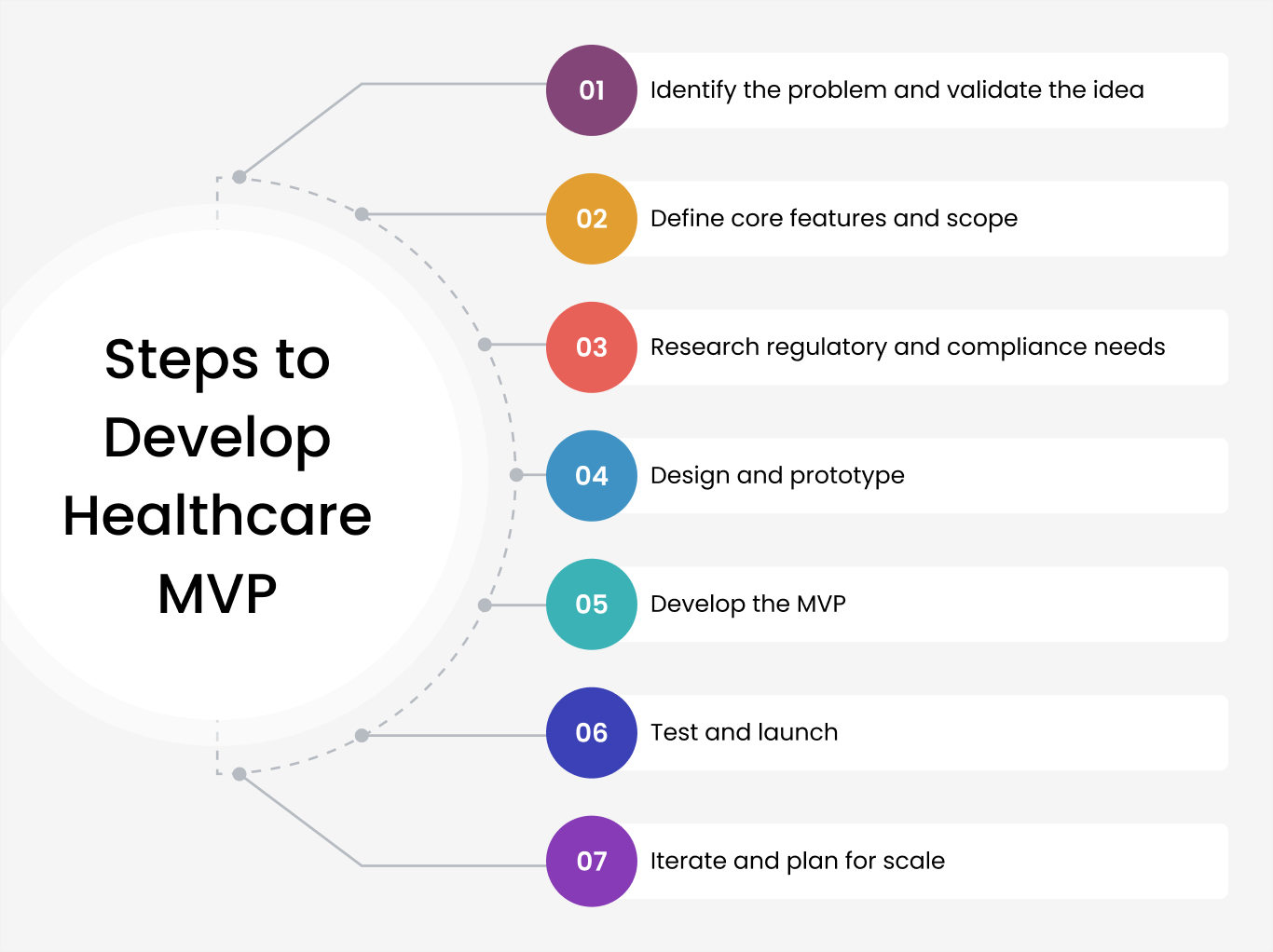
Identify the problem and validate the idea
Start by identifying a specific and urgent healthcare industry challenge that your MVP will address. This step is crucial as it sets the foundation for your project. The healthcare industry is complex, with diverse stakeholders such as patients, providers, and insurers. Misidentifying the key pain points can lead to failure. By pinpointing the proper challenge, you’re actively engaging in the solution process.
Validation is a key step that ensures your innovative ideas are theoretical and resonate with real-world needs. It’s a risk-reducing process that aligns your product with your target audience’s expectations, giving you confidence in your solution.
How to identify the problems and validate the idea
- Research pain points through interviews, surveys, or observation (e.g., long diagnostic delays and poor patient-provider communication).
- Define your target audience, such as rural patients or busy clinicians.
- Validate your concept with potential users and analyze competitors to ensure it fills a gap.
Define core features and scope
Establishing the core functionality your MVP software must include is crucial. This step ensures that your MVP effectively solves the identified problem while keeping the scope tight, enabling rapid software development and testing. It’s about delivering value without complicating the initial build.
In the healthcare industry, this means balancing user needs with feasibility, ensuring the healthcare product is both valuable and deliverable with minimal effort. The key goal is a focused tool that delivers value without complicating the initial build.
Steps to define core features and scope
- Brainstorm all potential features, then prioritize the top 2-3 critical ones.
- Consider the specific requirements of healthcare apps, such as accessibility or data integration.
- Document the scope to avoid feature creep.
Research regulatory and compliance needs
Understanding and integrating the legal and ethical standards that govern healthcare products is crucial. It ensures your MVP is safe, secure, and permissible for use. This step embeds trust and legality into your software architecture, providing a sense of security and confidence in your product.
The healthcare industry is heavily regulated, and non-compliance can hinder the effectiveness of your MVP or harm users, so this step embeds trust and legality into the software architecture from the outset. It’s about building a clear vision for credibility.
How to check for regulatory and compliance needs
- Identify applicable laws (e.g., HIPAA for privacy, GDPR if in Europe).
- Plan data encryption and security measures.
- Consult experts if the MVP approach involves medical advice or devices.
Design and prototype
Creating a tangible representation of your MVP software is a key step. This allows you to test concepts, refine usability, and gather feedback from early adopters before full software development. In healthcare, where users may have varying levels of tech literacy or unique challenges, prototyping ensures the design is both intuitive and practical. This stage tests innovative ideas against real-world use cases.
In healthcare, where users may have varying tech literacy or unique challenges (e.g., clinicians under time pressure), prototyping ensures the design is intuitive and practical. This stage tests innovative ideas against real-world use cases.
Steps to move ahead with design and prototype
- Sketch wireframes or use tools like Figma for mockups.
- Create a clickable prototype that focuses on core functionality.
- Test the prototype with a small group of users for initial reactions.
Develop the MVP
Build a functional, minimal version of your healthcare product that customers can use, emphasizing speed, reliability, and data encryption. This step transforms your prototype into a working MVP of software for real testing, adhering to the high standards of the healthcare industry. The key goal is to deliver success with the least effort while proving value to early adopters.
Steps to start the development of MVP
- Select a software architecture (e.g., Flutter for cross-platform apps).
- Code the core functionality with a focus on stability and security.
- Use agile MVP software development to iterate quickly.
Test and launch
Validating the MVP’s performance in a controlled testing stage and releasing it to a limited market is critical. This process ensures the new product works as intended and meets customers’ needs. In healthcare, this confirms user safety and effectiveness before scaling metrics are applied. It’s the real test of success.
How to test and launch your MVP product
- Run usability and security testing with a small group.
- Launch to a pilot audience, such as a single clinic or patient group.
- Track usage and gather user feedback via surveys or interviews.
Iterate and plan for scale
Refine the effective MVP based on user feedback and performance data while laying the groundwork for broader adoption and future enhancements. This step evolves the healthcare product to serve its market better and prepares the team for growth, ensuring sustainability and competitiveness. It turns early success into a scalable solution with maximum impact.
How to perform iteration and plan for scale
- Analyze feedback to fix issues or add high-priority features.
- Update the MVP and retest with users.
- Plan infrastructure and funding for scaling metrics (e.g., cloud upgrades).
Does Your Healthcare MVP Meet Clinical, Compliance, and ROI Goals?
Contact us today for a free consultation, and let our experts help you validate your MVP against clinical standards, ensure compliance with regulations like HIPAA and GDPR, and optimize for maximum ROI.
Key Considerations Before Building an MVP for Healthcare
Developing an MVP for healthcare apps is not just about speed; it’s also about balancing innovation with compliance, user trust, and operational feasibility. Here are some crucial considerations that every healthcare startup should factor into their MVP software development process:
- Privacy & Data Security: Healthcare products handle sensitive patient data. Implement strong data encryption, secure authentication, and role-based access. Ensure compliance with regulations like HIPAA or GDPR.
- Usability for Diverse Users: Design intuitive and straightforward healthcare apps for patients, doctors, and admins. Focus on clarity, accessibility, and workflows that address their unique challenges.
- Timeline Management: Keep the MVP process within 2–3 months. It controls costs, accelerates feedback collection, and helps validate core features faster.
- Budget Allocation: Invest wisely in MVP software development, compliance, security, and user testing. Start lean, validate your healthcare product, and scale based on honest user feedback.
Challenges in Healthcare MVP Development
Building an MVP for healthcare is more than just achieving speed to market; it’s about building with precision, compliance, and user trust. The healthcare industry has its own set of complex challenges that demand a strategic and well-planned MVP approach.

Strict Regulatory Compliance
Healthcare products operate in a highly regulated environment. Adhering to HIPAA, GDPR, or HL7 compliance standards is non-negotiable to ensure legal safety and patient trust.
Data Privacy & Security Risks
MVP software handling sensitive patient data must implement advanced data encryption, secure user authentication, and role-based access control to prevent security breaches.
Complex & Diverse User Roles
Healthcare solutions must serve multiple user personas, such as doctors, patients, caregivers, and administrators. Each has specific workflows and expectations.
Integration with Legacy Systems
Healthcare apps often need to seamlessly integrate with existing systems, such as EMRs, EHRs, and telehealth platforms, making integration a key technical challenge.
Shifting User Expectations
Feedback collected from early adopters may reveal evolving customer needs, requiring flexibility in the MVP process for continuous improvements and new feature rollouts.
Managing Cost & Development Risks
Investing heavily without real testing can lead to failed concepts. A well-defined MVP helps minimize risks by focusing on core features that solve actual pain points before scaling.
Cost to Develop a Minimum Viable Product for the Healthcare Industry
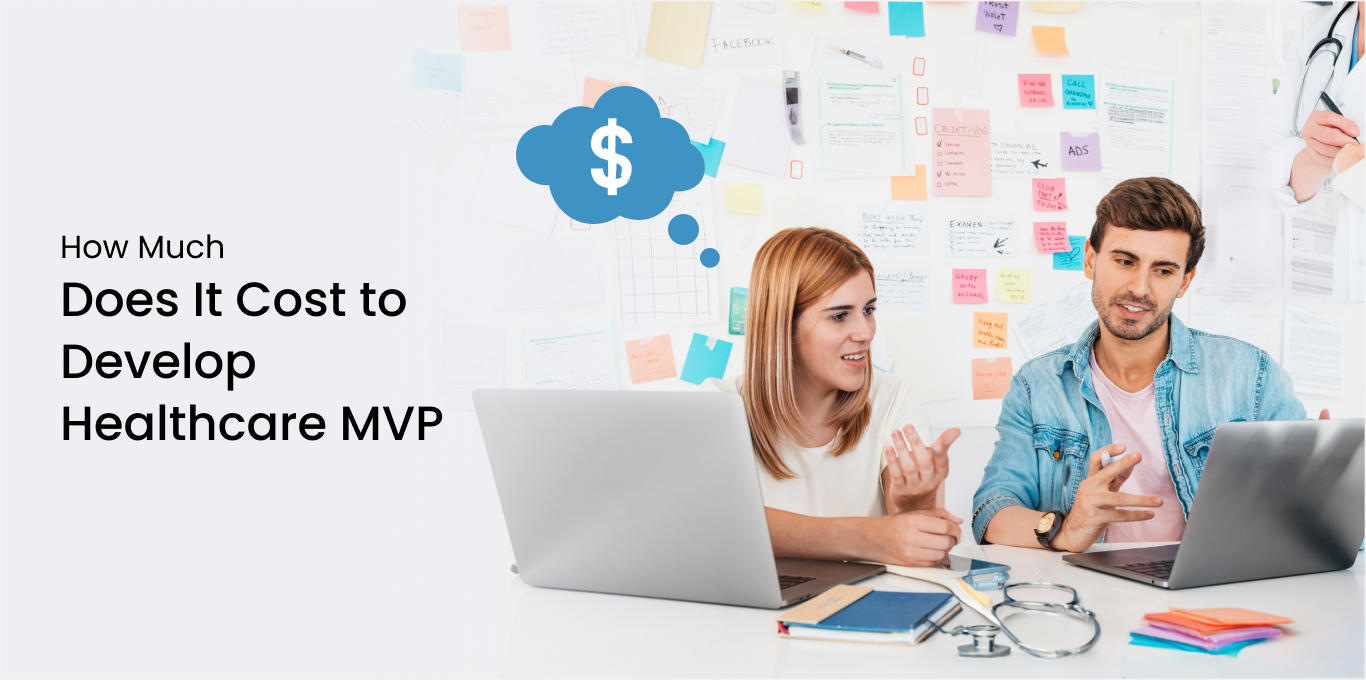
The average cost to develop an MVP for the healthcare industry ranges from $25,000 to over $ 60,000, depending on complexity. Developing an MVP is a strategic way to test innovative solutions, manage costs, and ensure compliance with industry standards.
These costs are customized to reflect the unique demands of healthcare, including regulatory compliance, data security, and user experience for both patients and providers.
Cost breakdown for healthcare MVP development
Below is a table outlining the average cost to develop an MVP in the healthcare industry, categorized by complexity:
| MVP Type | Cost Range | Description |
|---|---|---|
| Simple Healthcare MVP | $25,000 to $35,000 | Basic features like appointment booking, user profiles, and minimal integrations. |
| Mid-Level Healthcare MVP | $35,000 to $50,000 | Adds features like telemedicine, EHR integration, and basic analytics. |
| Complex Healthcare MVP | $50,000 to $60,000+ | Includes advanced functionalities like AI diagnostics, HIPAA-compliant security, and multi-platform support. |
Top 5 factors that influence the cost of an MVP for healthcare
The cost of building an effective MVP depends not only on what you want to develop, but also on how you want it to function. Here are the key factors that directly impact the development cost.
-
Feature Set & MVP Complexity
A simple healthcare MVP with essential features like a patient portal, appointment scheduling, and notifications may cost around $25,000. A mid-level MVP with telemedicine functionality and EHR integration can cost $50,000. A complex MVP equipped with AI-driven diagnostics, wearable device syncing, and multi-user dashboards can exceed $60,000. -
Regulatory Compliance Impact
Healthcare MVPs must adhere to HIPAA (U.S.) or GDPR (EU) standards, which require secure data encryption and privacy features. This can add 10–20% to development costs, especially for complex systems handling sensitive patient data. -
Development Team Location & Cost
U.S.-based developers charge $50–$150 per hour, while offshore teams (e.g., in India) range from $25–$50 per hour. A typical MVP takes 500–1,200 hours, aligning with the cost ranges mentioned above. -
Technology Stack Selection
Basic MVPs often use off-the-shelf frameworks (e.g., React Native for apps), which helps keep costs low. Complex MVPs requiring custom APIs, cloud infrastructure (e.g., AWS), or blockchain for data integrity drive expenses higher. -
Timeline & Cost Correlation
A 3–4 month timeline is standard for a simple MVP, while complex MVPs may take 6 months or more, which can increase labor costs significantly due to extended development cycles.
By starting with a focused feature set and leveraging insights from early users, healthcare innovators can refine their products efficiently while staying within budget. Ready to build a pocket-friendly MVP? Hire software developers from Space-O Technologies to build MVP.
Want to Avoid Costly Mistakes in Your MVP Journey?
Partner with experts who have done it before and know the healthcare space inside and out.
MVPs Developed By Space-O Technologies
Every successful digital product starts with a strong MVP strategy. Over the years, we have helped numerous startups and enterprises turn their ideas into scalable products by building minimum viable products (MVPs) that focus on solving real-world problems.
From healthcare and eLearning to logistics and transportation, our MVP development approach ensures faster time-to-market, reduced development risks, and early user validation.
Every successful digital product starts with a strong MVP strategy. Over the years, we have helped numerous startups and enterprises turn their ideas into scalable products by building minimum viable products (MVPs) that focus on solving real-world problems.
From healthcare and eLearning to logistics and transportation, our MVP development approach ensures faster time-to-market, reduced development risks, and early user validation.
Conduet — A smart healthcare communication platform
Conduet — a healthcare communication platform developed by our Space-O Technologies team, is an excellent example of a successful healthcare MVP. The core idea behind Conduet was to simplify communication between patients, caregivers, and healthcare providers, while ensuring data privacy and compliance with HIPAA.
In its MVP stage, Conduet focused on key features such as appointment scheduling, real-time notifications, secure messaging, and centralized access to health records. By starting with these essential features, the app quickly solved a critical problem for its users while creating room for future enhancements based on real feedback.
Built an e-learning platform that secured $1.4 million in funding
Our team at Space-O Technologies successfully developed Fyule Video Lab, an innovative video-based eLearning platform designed to transform students’ learning. Starting with an MVP, we focused on creating a scalable, user-friendly solution that evolved into a full-fledged product.
This strategic approach played a key role in Fyule Video Lab raising $1.4 million in funding from an Angel syndicate featuring senior executives from leading organizations like Google, Deloitte, Tata 1mg, and Axis Capital.
Optimizing logistics operations with One8 MVP
At Space-O Technologies, we started with a minimum viable product (MVP) approach to building One8, a transportation management system designed to simplify logistics operations. The MVP version focused on solving the core challenges of real-time shipment tracking and driver coordination, helping logistics businesses experience immediate value.
After successful validation and user feedback, we scaled One8 into a full-fledged transportation management platform. Developed using the MERN stack (MongoDB, Express.js, React.js, Node.js), the solution enables businesses to manage shipments efficiently, access live driver updates, and maintain greater administrative control.
Most Popular Tech Stack for MVP Development
Developing an MVP is not just about developing fast; it’s about choosing the right technologies that allow flexibility, scalability, and speed while optimizing costs.
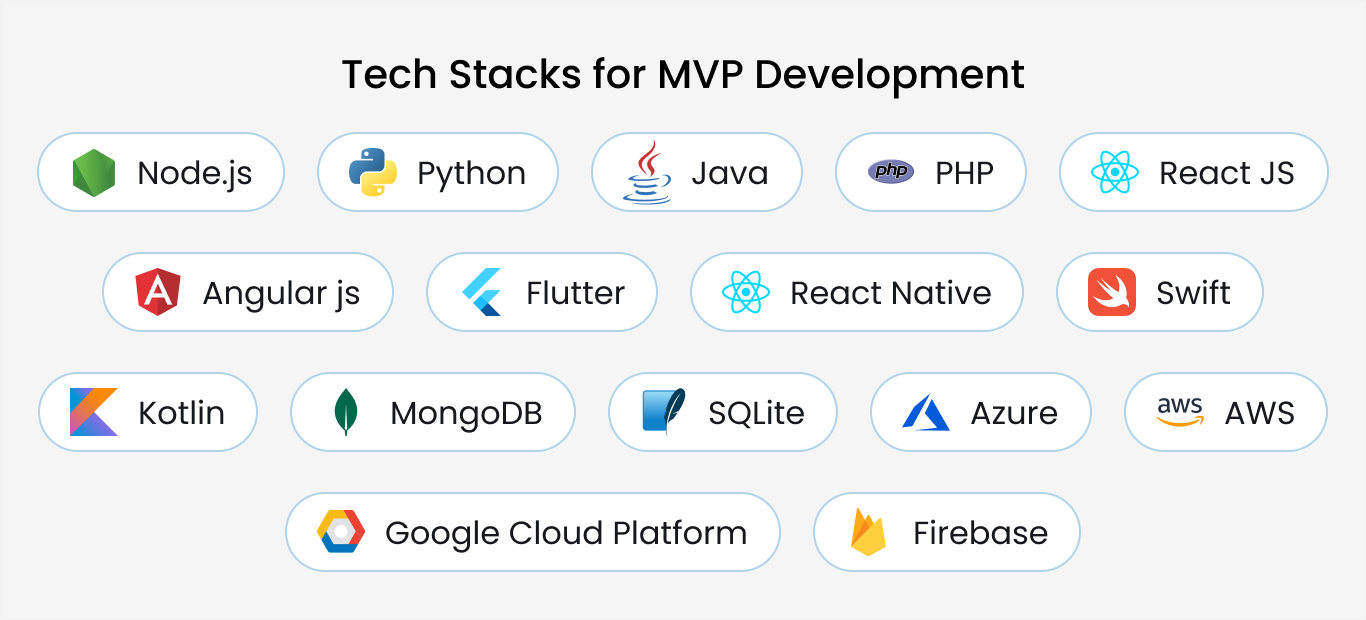
At Space-O Technologies, we carefully select the technology stack based on the project requirements, product type, and future scalability needs.
Here’s a complete breakdown of technologies commonly used in MVP development:
| Technology | Usage/Purpose |
|---|---|
| Laravel / PHP | Backend development for secure and scalable web applications |
| Node.js / Express.js | Backend development for real-time and event-driven applications |
| Python / Django | Suitable for AI/ML integration and data-driven applications |
| React.js / Vue.js / Angular | Frontend development for responsive and interactive web interfaces |
| Flutter / React Native | Cross-platform mobile app development for both iOS & Android |
| Kotlin / Swift | Native mobile app development for Android (Kotlin) and iOS (Swift) |
| MongoDB / MySQL / PostgreSQL | Database management based on scalability and structure needs |
| Firebase | Real-time database, authentication, and cloud storage for MVPs |
| AWS / Microsoft Azure / Google Cloud | Cloud hosting, storage, and deployment solutions |
| GraphQL / REST API | Seamless data transfer and API integrations |
| Docker / Kubernetes | Deployment, containerization, and scaling of MVP applications |
| Stripe / PayPal / Razorpay | Secure payment gateway integrations |
| Twilio / SendGrid / Firebase Cloud Messaging | Real-time notifications, SMS, email, and chat features |
| GitHub / Bitbucket / GitLab | Version control and collaborative development |
Looking to Develop a Healthcare MVP?
Building a MVP app for healthcare is a strategic investment that validates your vision, mitigates risk, and accelerates time to market. With a well-structured roadmap that covers identifying core features, ensuring strict compliance, and executing thorough testing and iteration, you can transform your concept into a healthcare solution that effectively serves both patients and providers.
At Space‑O Technologies, we specialize in guiding healthcare startups and enterprises through every step of the MVP journey. Whether you need help navigating HIPAA or GDPR requirements, architecting a scalable and secure app, or designing an intuitive user experience, our cross-functional teams bring deep domain expertise and proven processes.
Ready to Transform Your Healthcare Concept into a Market‑Ready MVP?
Contact us today for a free consultation and discover how we can help you launch a compliant, high‑impact healthcare MVP on time and within budget.
FAQs Based on MVP for Healthcare Apps
What is the typical timeline for developing a healthcare MVP?
A basic healthcare MVP can typically be developed in 6 to 8 weeks, while a feature-rich, fully compliant solution may take 3 to 6 months, depending on its complexity, integrations, and regulatory requirements.
Here is the breakdown of the timeline that our expert team takes to deliver an MVP solution.
- Discovery & Validation (2–3 weeks): We identify pain points, validate ideas with users, and define core features to make your solution market-fit.
- Design & Development (2–4 weeks): Our team starts wireframing, developing clickable mockups, and gathering early feedback to improve them.
- Testing & Pilot Launch (2–3 weeks): We conduct usability, security, and compliance tests, then release them to a limited audience.
- Iteration Planning (ongoing): Analyzing feedback and usage data to prioritize the next phase of the development process.
How is a healthcare MVP different from a Proof of Concept (PoC)?
A PoC tests technical feasibility (“Can we build this?”), whereas an MVP delivers a usable, minimal app to early adopters to validate market demand and user workflows (“Will people actually use this?”).
What core team roles are needed to build a healthcare MVP?
At minimum: a product owner (defines scope), a UX/UI designer (prototypes flows), backend/frontend developers (build features), a QA/security engineer (compliance & testing), and a clinical or domain advisor (validates workflows).
What criteria should guide my choice of tech stack for a healthcare MVP?
Prioritize security‑first frameworks (e.g., Spring Boot, Django), cross‑platform tools if you need iOS/Android (Flutter, React Native), and managed cloud services (HIPAA‑eligible AWS/GCP) to minimize infrastructure overhead.
How can I recruit and motivate early adopters to test my MVP?
Partner with a single clinic or patient advocacy group, offer incentives like free access or data insights, and involve them in co-design workshops so they feel a sense of ownership and provide richer feedback.
How do I stay compliant as regulations like HIPAA and GDPR evolve?
Build automated compliance checks (such as audit logs and encryption at rest), subscribe to regulatory update services, and schedule periodic reviews with a legal or compliance expert to adjust policies and technical controls.
